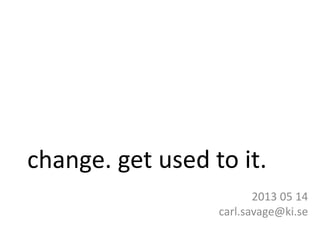change. get used to it.
- 1. 2013 05 14 carl.savage@ki.se get used to it.change.
- 2. SETTING THE STAGEŌĆ” 1. whatŌĆÖs the use of theory? 2. why do science? 3. why use methods?
- 3. Your mission: Become a health care quality improvement leader.
- 4. The challenge: ŌĆØGet MDŌĆÖs to use EBM protocolsŌĆØ Pay-for-performance Analyze dissemination process Workshops to motivate quality Continuous feedback Educate the staff in use of guidelines Understand MDŌĆÖs situation and change their perceptions Talk with physicians Change medical education Identify opinion leaders Include in licensing
- 5. Content Process Context ŌĆó Change managers ŌĆó Models of change ŌĆó Formulation/implementation ŌĆó Pattern through time ŌĆó Assessment and choice of products and markets ŌĆó Objectives and assumptions ŌĆó Targets and evaluation Internal ŌĆó Resources ŌĆó Capabilities ŌĆó Culture ŌĆó Politics External ŌĆó Economic/Business ŌĆó Political ŌĆó Social (Pettigrew & Whipp, 1993) Essential ingredients of change
- 7. What AND how, not just what! ŌĆØŌĆ”any transformation journey requires innovation both in what you do and in how you do it.ŌĆØ (Nayar, 2010)
- 8. 1. Why? 2. How? 3. What (Sinek, 2011)
- 9. Some current change scenarios What is your strategy? 1. Launch a stop smoking campaign at work. 2. Set up a meeting time with a group of 4-5 busy professionals. 3. Convince a primary care clinic to measure patient outcomes. 4. Implement process improvement in a hospital (IHC).
- 10. Reflect on your change strategies ŌĆó What are the similarities and differences between your change strategies? ŌĆó Why do you think your strategies would work? ŌĆó What assumptions have you made? ŌĆó How have you addressed those assumptions?
- 11. 1. Why? 2. How? 3. What (Sinek, 2011)
- 12. ASSUMPTIONS Power and the people
- 13. ASSUMPTION 1. change is hard because of resistance to change
- 16. (Rogers, 1962)
- 18. MONEY. itŌĆÖs the most expensive way to motivate people
- 19. THE CASE OF X & Y Y: ŌĆØI could use your helpŌĆ”ŌĆØ
- 20. Motivation 2.0 Theory X ŌĆó Dislike working. ŌĆó Avoid responsibility and need to be directed. ŌĆó Have to be controlled, forced, and threatened to deliver what's needed. ŌĆó Need to be supervised at every step, with controls put in place. ŌĆó Need to be enticed to produce results; otherwise they have no ambition or incentive to work. Theory Y ŌĆó Take responsibility and are motivated to fulfill the goals they are given. ŌĆó Seek and accept responsibility and do not need much direction. ŌĆó Consider work as a natural part of life and solve work problems imaginatively. (McGregor, 1960)
- 21. Motivation 3.0 ŌĆó Purpose ŌĆō Is my work meaningful? ŌĆó Autonomy ŌĆō Do I have the freedom to do my work? ŌĆó Mastery ŌĆō Do I have the opportunity to become better and better at what I do? (Pink, 2006)
- 22. ASSUMPTION 3. the path of change is linear
- 29. Unfreeze ŌĆó Awareness of shortcomings ŌĆó Uncertainty leads to motivation to change Move ŌĆó Search for knowledge and new examples (Re)Freeze ŌĆó New identity ŌĆó New structures (Lewin, 1951) carl.savage@ki.se
- 30. Conventional Wisdom on Change Kotter 1. Establish a sense of urgency 2. Create the guiding coalition 3. Develop a vision and strategy 4. Communicate the change vision 5. Empower broad-based action 6. Generate short-term wins 7. Consolidate gains and produce more change 8. Anchor new approaches in the culture Modern Management Principles ’é¦ Standardization ’é¦ Specialization ’é¦ Goal alignment ’é¦ Hierarchy ’é¦ Planning and control ’é¦ Extrinsic rewards carl.savage@ki.se (Kotter, 1996) (Hamel, 2007) 2011-09-01
- 34. ŌĆØpilot errorŌĆØ ŌĆØtoo much airplane for one man to flyŌĆØ
- 35. Problem with Conventional Wisdom Identify a problem Call in the experts Design the perfect solution ŌĆØWhoopsŌĆØ carl.savage@ki.se ŌĆØDeficit-based solution-focused changeŌĆØ 2011-09-01
- 36. SO, WHY DO WE GET ŌĆØWHOOPSŌĆØ?
- 37. How did we get into this mess? Stress Look to authority Pressure on authority to ŌĆØdo somethingŌĆØ Temptation for a ŌĆØquick fixŌĆØ (Heifetz, 1994)
- 38. Stress Look to authority Pressure on authority to ŌĆØdo somethingŌĆØ Temptation for a ŌĆØquick fixŌĆØ = A leadership challenge (Heifetz, 1994)
- 39. ASSUMPTION 4. we need to lead change by pushing* change *communicating
- 40. Simple Complex Complicated Chaos Certainty Agreement Close to Closeto Far from Farfrom (Adapted from Stacey, 1996) Complicated Where we act like we are Where we actually are
- 41. (Glouberman & Zimmerman, 2002)
- 42. WhatŌĆÖs the [type of] problem? Situation Problem definition Solution and implementation Primary locus of responsibility for the work Kind of work Type I Clear Clear Physician Technical Type II Clear Requires learning Physician and patient Technical and adaptive Type III Requires learning Requires learning Patient > physician Adaptive (Heifetz, 1994)
- 43. Adaptive leadership 1. Get on the balcony a) Identify the adaptive challenge b) Regulate distress c) Direct disciplined attention to the issues (not stress reducing distractions) d) Give work back to the people, at a rate they can stand e) Protect voices of leadership without authority 2. Distinguish self from role 3. Externalize the conflict 4. Use partners 5. Listen, using oneself as data; live with doubt 6. Find a sanctuary 7. Preserve a sense of purpose (Heifetz, 1994)
- 44. Creative tension [What is] [What could beŌĆ”] Where is the tension?
- 45. Change management ŌĆó The Path ŌĆō Shape the path ŌĆó The Rider ŌĆō Direct the rider ŌĆó The Elephant ŌĆō Motivate the elephant (Switch, by Heath & Heath, 2010)
- 46. If you donŌĆÖt plan on improving things, donŌĆÖtbother.
- 47. CHANGE IS PERSONAL: IMPROVEMENT IS YOUR RESPONSIBILITY carl.savage@ki.se Medical Management Centre, KI










































![WhatŌĆÖs the [type of] problem?
Situation
Problem
definition
Solution and
implementation
Primary locus of
responsibility for
the work
Kind of work
Type I Clear Clear Physician Technical
Type II Clear Requires learning
Physician and
patient
Technical and
adaptive
Type III
Requires
learning
Requires learning
Patient >
physician
Adaptive
(Heifetz, 1994)](https://image.slidesharecdn.com/changemanagement20130514-130516060526-phpapp01/85/change-get-used-to-it-42-320.jpg)

![Creative tension
[What is]
[What could beŌĆ”]
Where is the tension?](https://image.slidesharecdn.com/changemanagement20130514-130516060526-phpapp01/85/change-get-used-to-it-44-320.jpg)


